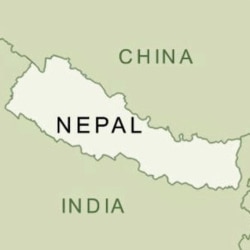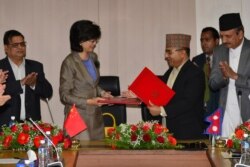Government officials in Nepal are pushing journalists to avoid critical reporting on China, one of the nation’s largest investors as part of Beijing’s One Belt, One Road project, a Nepalese journalist told VOA.
Anil Giri, foreign affairs correspondent for the Kathmandu Post, said journalists are discouraged from covering Tibetan affairs to mollify China and that government officials shy away from commenting on China-related issues.
China sponsors junkets for Nepalese journalists and “that’s why probably we don’t see lots of criticism about China’s growing investment in Nepal, Chinese doing business in Nepal and China’s growing political clout in Nepal,” Giri said.
He said Nepali government officials shy away from reporters seeking comments on China-related stories.
Conduct found ‘unsatisfactory’
The sensitivities extend beyond the press. The Kathmandu Post reported earlier this week that the Samajbadi Party of Nepal suspended lawmaker Pradip Yadav for six months for attending a Tibet support conference in Europe last month. The party reached the decision after finding his explanation for attending a program called “Free Tibet” in the Latvian capital Riga “unsatisfactory.”
Nepal, one of the world’s poorest countries, shares borders with China and India. The border with China along the Himalayas passes through Tibet, which China considers part of its territory, a view rejected by many Tibetans.
China wants to control the movement of Tibetans to India, which started after a failed uprising in 1959. There are now about 20,000 exiled Tibetans living in Nepal.
Nepal and China signed a memorandum of understanding (MoU) on bilateral cooperation under the framework of China’s Belt and Road Initiative (BRI) in May 2017. Nepal received foreign direct investment (FDI) pledges from China of $57 million in 2015-16, $76 million in fiscal 2016-17 and $427 million U.S. dollars in fiscal 2017-18, according to Xinhuanet.
Such investment comes at a price, said Cedric Alviani, director of the Asia Bureau of Reporters Without Borders.
“For the Belt and Road Initiative to be fully successful” and reach its full potential as envisioned by China, “the population of every country taking part in the project has to be enthusiastic,” Alviani said. “But of course, just like any project led by a foreign country, there are many questions.”
Such questions must be suppressed when a country joins the Belt and Road project, Alviani said, adding, “For this development to become successful, the media must be muzzled.”
Reporters Without Borders has accused China of creating a “new world media order.” The Chinese Embassy in Washington did not respond to numerous requests for comment.
Nepal is careful in dealing with Tibet issues to avoid offending its powerful neighbor, Giri said.
Journalists investigated
In June, Nepalese government officials began investigating three journalists from a state-run news agency Rastriya Samachar Samiti (RSS) who reported on the discharge of the Dalai Lama from a New Delhi hospital. The agency’s chair, Hari Adhikari, told Indian news outlets that the issue was “very sensational for us.”
Gokul Baskota, Nepal’s minister of communications and information technology, told the Kathmandu Post that he ordered the investigation.
“We should be sensitive to our neighbor’s concerns,” he told the newspaper.
Dilliram Batarai, one of four members of a committee assigned by RSS chairman Harikar Adhikari, said, “RSS is a state-run news agency, however, and our investigation will be guided by Nepal’s relationship with China, by the One-China policy, and by Nepal’s foreign policy. So we report to higher authorities.”
Meenakshi Ganguly, South Asia director of Human Rights Watch, said, “Presumably, the price of friendship for some governments is to prevent anything that reflects poorly on China, and any reminder of the repression in Tibet is something that does reflect very poorly.”
“Nepal has been shutting down peaceful protests by Tibetans, even when it comes to displaying flags or posters,” Ganguly said.
Giri said it is not a lack of Nepali people’s interest in Tibet, but the government’s fear of China that puts discussion of Tibet off-limits.
“There is extreme pressure from China. The expanding cloud of influence or pressure from China over different sectors” means people are afraid to speak openly for the Tibetan refugee community, he added.
But China wants even “the idea of independent journalism to disappear,” Aviani said. “And this might happen in one or two generations if democracies do not react and fight against it.”
Rajani Tamang is an editor with Nepal’s Kantipur Television Network (KTV), who is working in VOA’s Tibetan Service as part of State Department’s Professional Fellows Program.







